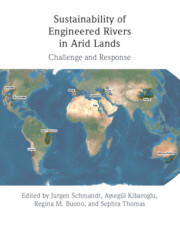Book contents
- Sustainability of Engineered Rivers in Arid Lands
- Sustainability of Engineered Rivers in Arid Lands
- Copyright page
- Dedication
- Contents
- Contributors
- Part I Introduction
- Part II Challenge
- Part III Engineered Rivers
- 7 The Nile River Basin
- 8 The Euphrates–Tigris River Basin
- 9 The Yellow River Basin
- 10 The Murray–Darling River Basin
- 11 The São Francisco River Basin
- 12 The Limarí River Basin
- 13 The Colorado River Basin
- 14 The Rio Grande / Río Bravo Basin
- 15 The Jucar River Basin
- Part IV Response
- Part V Conclusion
- Index
- References
8 - The Euphrates–Tigris River Basin
from Part III - Engineered Rivers
Published online by Cambridge University Press: 16 September 2021
- Sustainability of Engineered Rivers in Arid Lands
- Sustainability of Engineered Rivers in Arid Lands
- Copyright page
- Dedication
- Contents
- Contributors
- Part I Introduction
- Part II Challenge
- Part III Engineered Rivers
- 7 The Nile River Basin
- 8 The Euphrates–Tigris River Basin
- 9 The Yellow River Basin
- 10 The Murray–Darling River Basin
- 11 The São Francisco River Basin
- 12 The Limarí River Basin
- 13 The Colorado River Basin
- 14 The Rio Grande / Río Bravo Basin
- 15 The Jucar River Basin
- Part IV Response
- Part V Conclusion
- Index
- References
Summary
On top of dealing with climate change impacts on rainfall and temperature, and rising populations and development, the Euphrates–Tigris basin also faces conflict and instability. The Syrian Civil War, the presence of many nonstate armed groups, and the lack of coordination between Turkey, Syria, and Iraq to manage the water resources can lead to continued political confrontation and economic disintegration. This complicates the existent issue of nexus in the Euphrates–Tigris basin. The conflicting needs of energy, water, and food require more coordination not just between countries but between sectors within the countries. Each sector must be allocated a certain amount of water based on the needs it fulfills for the country. If violence continues and instability in the region is not resolved, these demands may increase and further pressure the basin.
Keywords
- Type
- Chapter
- Information
- Sustainability of Engineered Rivers In Arid LandsChallenge and Response, pp. 94 - 106Publisher: Cambridge University PressPrint publication year: 2021
References
- 3
- Cited by



